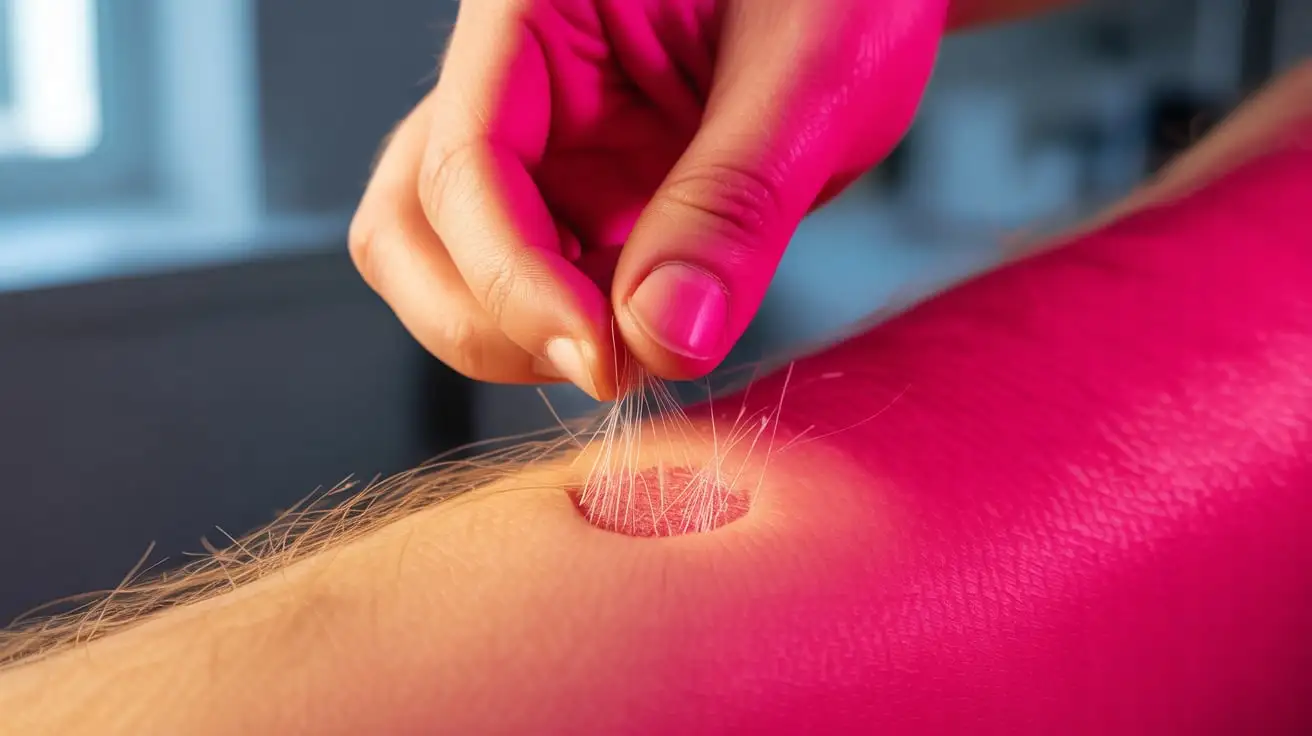To remove fiberglass from your skin, rinse the area with cool water and gently use clear Tape or clean tweezers to remove the fibers. Don’t rub or scrub, it can push the fiberglass deeper and make your skin hurt more. Fiberglass splinters are tiny, sharp pieces that can get stuck in your skin when you work with insulation, boats, or construction materials. They can cause itching, burning, or a prickly feeling.
Table of Contents
ToggleFortunately, learning how to remove fiberglass from skin is straightforward if you follow the correct steps. This guide will show you how to remove it safely, care for your skin afterward, and know when to consult a doctor.
How to Get Fiberglass Out of Skin
Here’s a quick guide if you need fast help:
- Stop working and move away from the fiberglass.
- Don’t scratch or rub your skin.
- Take off your clothes carefully to avoid spreading the fibers.
- Rinse your skin with cool running water, no scrubbing.
- Use Tape or tweezers to lift out any visible fibers.
- Wash again, dry gently, and apply moisturizer.
- See a doctor if the fibers are deep or the area looks infected.
How to Know if Fiberglass Is in Your Skin
You might have fiberglass stuck in your skin if you notice tiny white or clear hairs on your skin, redness, bumps, or a rash, itching, stinging, or burning that doesn’t go away, or a rough or gritty feeling when you touch the spot. This usually happens on the arms, legs, hands, or face, the areas most often uncovered while working.
First Aid: What to Do Right Away
Stop what you’re doing and move to a clean area. Remove any clothing that may have fiberglass on it, roll it off your body, rather than pulling it over your head. Rinse your skin with cool water for a few minutes. Don’t scrub or use hot water, that opens your pores and makes things worse. Stay calm and skip harsh chemicals or alcohol-based cleaners.
Easy Ways to Remove Fiberglass at Home
If your skin still feels itchy, try these simple methods to safely remove fiberglass. These are gentle, easy exercises that can be done at home.
1. Use Tape
Use clear packing tape or duct tape. Gently press the sticky side onto the affected area, and slowly peel it off, avoiding yanking it. Repeat with the new Tape until the area feels better. This is the best method for small, shallow fibers.
2. Use Tweezers
Clean your tweezers with rubbing alcohol first. Look closely under good light, gently pull out any visible fibers in the same direction they entered, and wash the area again with soap and cool water. Avoid poking or digging, that can cause more irritation.
3. Wash with Soap and Water
Use mild soap and cool water. Gently rub the area with a soft washcloth or gauze pad, then rinse well and pat dry (avoid rubbing). This helps remove tiny fibers you can’t see.
4. Clean Everything Up
After you finish, vacuum your work area and shower floor. Wash all clothes separately in warm water. Use gloves next time you handle fiberglass. Knowing how to remove fiberglass from skin also means keeping your surroundings clean so it doesn’t happen again.
Do’s and Don’ts
Do:
- Wear gloves
- Use Tape or tweezers gently
- Rinse with cool water
- Apply lotion or aloe vera afterward
Don’t:
- Scratch or scrub hard
- Use alcohol, bleach, or vinegar
- Try to dig fibers out
- Ignore pain or swelling
How to Clean and Care for Your Skin
After removing the fiberglass, wash the skin again with mild soap, pat it dry with a clean towel, and apply aloe vera or unscented lotion to calm the area. Wash any clothes or towels that may have fibers on them, and keep the area clean and uncovered to allow it to heal. These steps help ensure that you’ve completely handled the safe removal of fiberglass from your skin.
How to Relieve Itching and Pain
Use a cold cloth or ice pack for 10 minutes. Try antihistamines (such as Benadryl) for itching. Use Hydrocortisone Cream to calm redness. Take ibuprofen or acetaminophen for pain relief. Alternatively, try natural soothers, such as aloe vera gel or cool oatmeal baths. If your skin worsens after a day or two, see a doctor.
When to See a Doctor
Seek medical help if you notice pus, swelling, or severe redness; the area feels hot or very painful; fiberglass gets into your eyes or mouth; or you experience trouble breathing or facial swelling. Doctors can remove deep fibers, clean the wound, and prescribe medication if it becomes infected.
What Doctors Might Do
At the clinic, the doctor may:
- Use sterile tweezers or small tools to remove fibers
- Numb the area if needed
- Clean the wound with water or an antiseptic
- Give you antibiotic or steroid creams
- Send you to a specialist if it’s near your eyes or lungs
How to Avoid Fiberglass Problems Next Time
- Wear long sleeves, gloves, and goggles when handling fiberglass
- Use disposable coveralls or dedicated work clothes
- Work in a well-ventilated area
- Use wet sanding or cutting to keep dust low
- Vacuum with a HEPA filter and clean up after
- Wash your skin and hair as soon as you’re done working
Common Mistakes to Avoid
- Scrubbing your skin too hard
- Using dirty tweezers or sharp tools
- Ignoring tiny fibers that can cause infection later
- Forgetting to clean your workspace or clothes
Frequently Asked Questions
Will fiberglass go away on its own?
Sometimes, small fibers fall out naturally, but deeper ones require removal.
Is fiberglass dangerous?
It usually only irritates the skin, but it can cause infection if not cleaned properly.
Can fiberglass get into my blood?
No, it stays in the top layer of your skin, but it can still irritate.
What if fiberglass gets in my eye?
Rinse with clean water for 15 minutes and seek medical attention immediately.
Can kids be treated at home?
Yes, if it’s mild. Use Tape or rinse gently, but see a doctor if they’re in pain.
What takes fiberglass out of skin?
Clear tape, tweezers, or gentle washing with soap and water can help remove fiberglass from skin.
Will fiberglass come out on its own?
Small fiberglass splinters may eventually fall out, but deeper fibers typically require manual removal.
How long does fiberglass last in skin?
Fiberglass can irritate the skin for days to weeks if not removed, and may lead to infection if left untreated.
What dissolves fiberglass?
Fiberglass doesn’t dissolve in the skin; it must be physically removed using methods like tape or tweezers.
Conclusion
Fiberglass can be irritating, but it’s easy to handle if you act fast. Simply rinse, gently remove the fibers, and keep your skin clean and calm. Now you know exactly how to get fiberglass out of skin safely at home, and how to keep it from happening again.


